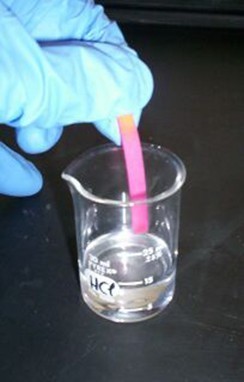Introduction to Logarithmic Properties
LEARNING OBJECTIVES
By the end of this lesson, you will be able to:- Use the product rule for logarithms.
- Use the quotient rule for logarithms.
- Use the power rule for logarithms.
- Expand logarithmic expressions.
- Condense logarithmic expressions.
- Use the change-of-base formula for logarithms.
 Figure 1. The pH of hydrochloric acid is tested with litmus paper. (credit: David Berardan)
Figure 1. The pH of hydrochloric acid is tested with litmus paper. (credit: David Berardan)In chemistry, pH is used as a measure of the acidity or alkalinity of a substance. The pH scale runs from 0 to 14. Substances with a pH less than 7 are considered acidic, and substances with a pH greater than 7 are said to be alkaline. Our bodies, for instance, must maintain a pH close to 7.35 in order for enzymes to work properly. To get a feel for what is acidic and what is alkaline, consider the following pH levels of some common substances:
- Battery acid: 0.8
- Stomach acid: 2.7
- Orange juice: 3.3
- Pure water: 7 (at 25° C)
- Human blood: 7.35
- Fresh coconut: 7.8
- Sodium hydroxide (lye): 14
To determine whether a solution is acidic or alkaline, we find its pH, which is a measure of the number of active positive hydrogen ions in the solution. The pH is defined by the following formula, where a is the concentration of hydrogen ion in the solution
The equivalence of [latex]-\mathrm{log}\left(\left[{H}^{+}\right]\right)\\[/latex] and [latex]\mathrm{log}\left(\frac{1}{\left[{H}^{+}\right]}\right)\\[/latex] is one of the logarithm properties we will examine in this section.
Licenses & Attributions
CC licensed content, Shared previously
- Precalculus. Provided by: OpenStax Authored by: Jay Abramson, et al.. Located at: https://openstax.org/books/precalculus/pages/1-introduction-to-functions. License: CC BY: Attribution. License terms: Download For Free at : http://cnx.org/contents/[email protected]..
